Salteñas, a national dish of Bolivia, are golden-hued football-shaped empanadas. These savory pockets are stuffed with a stewy mixture of meat and vegetables, in this case chicken, potatoes, and peas.
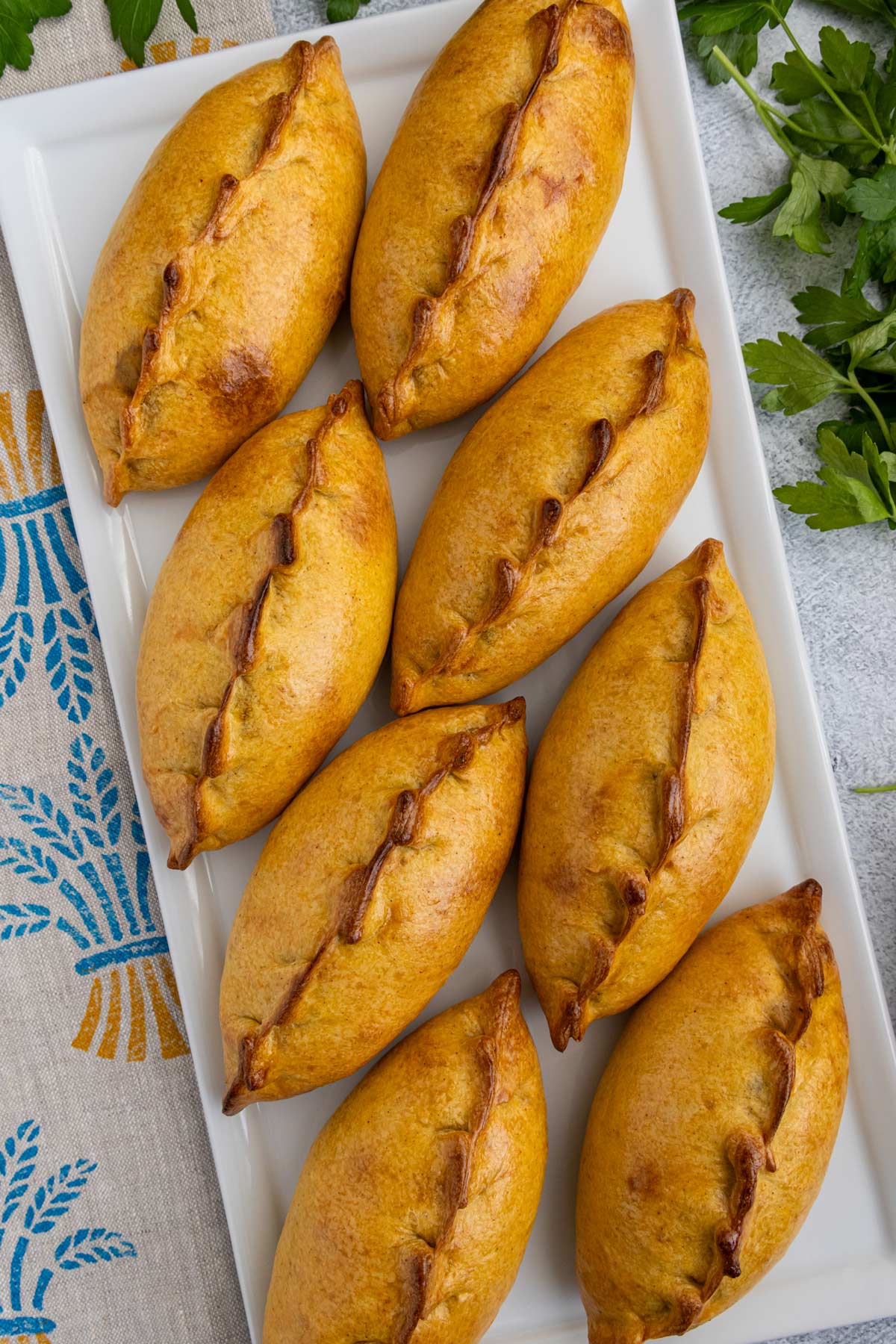
(This post was originally published in May 2015, but was updated with new photos and content and an updated and improved recipe in 2024).
Salteñas are baked Bolivian empanadas. They feature a slightly sweet golden-hued dough and a rich, stew-like filling usually made with either beef or chicken. The filing also typically includes chunks of potatoes, peas, and other herbs, spices, and seasonings. Additionally, salteñas sometimes contain raisins, olives, and/or hard-boiled eggs.
They’re shaped like chubby footballs with a folded or braid-like seam along the top, rather than the typical flat crescent-shaped empanadas from other Latin American nations.
This recipe for Salteñas de Pollo uses shredded chicken and chicken broth or stock as the main components for the stewed filling. You could easily use shredded or ground beef and beef broth or stock to make a beef version if you prefer.
Gelatin is used to jell the filling, making it easier to assemble once the filling cools and solidifies. Salteñas de pollo can be a bit time consuming to make, as you need to chill the filling thoroughly before you can begin assembling them.
After baking, the broth in the filling melts back into a liquid, resulting in a juicy pocket of chicken and potato stew. The slightly sweet dough yields a crispy contrast to the savory filling. Bolivian empanadas salteñas are often served for breakfast or enjoyed as a midday snack.
Salteñas can be notorious for making a mess while you eat them. To do so like a pro, hold the pastry upright, bite off the top corner and sip the stew as you consume the rest of the pastry.
Ingredient notes
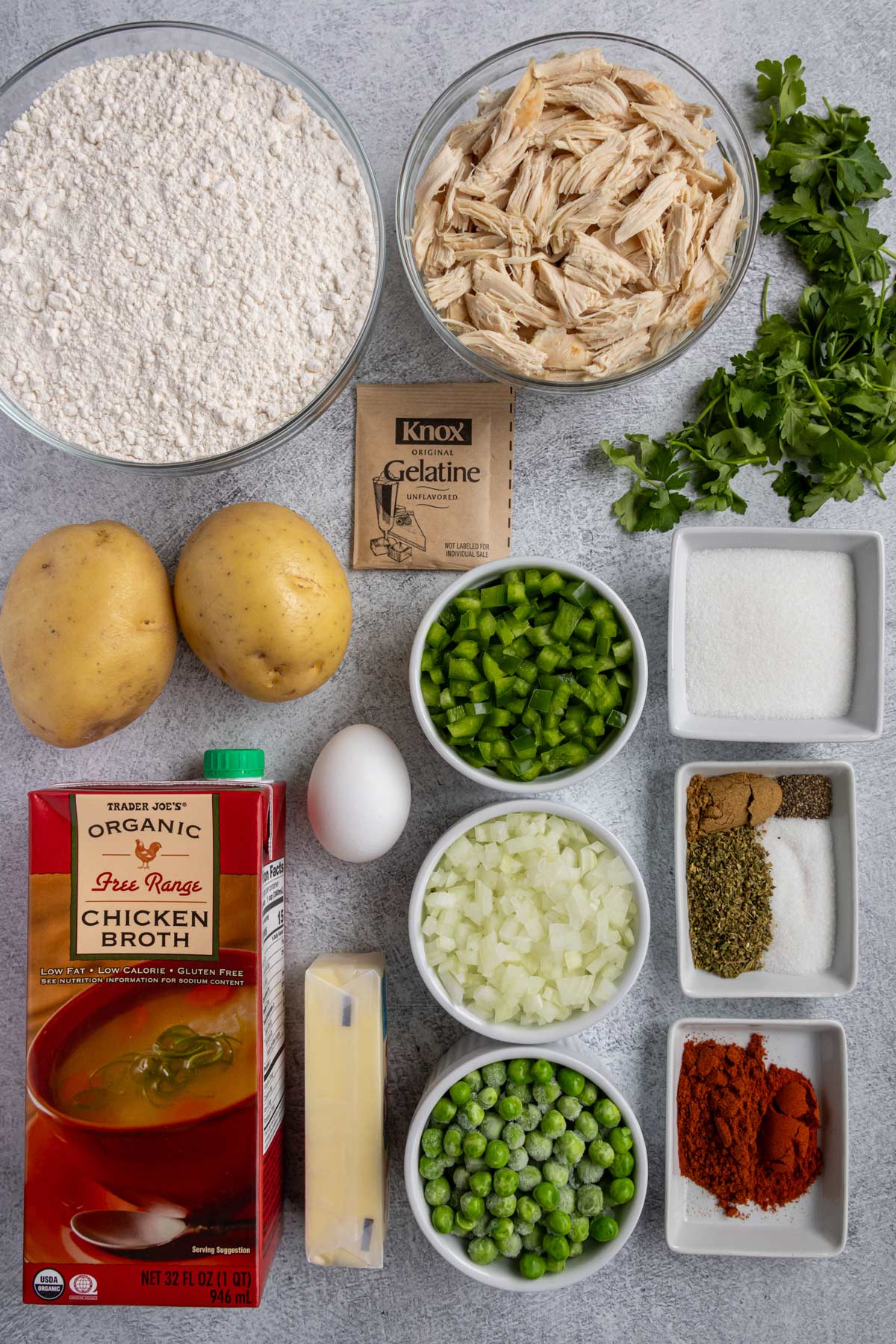
- Chicken: You’ll need shredded chicken for the filling. You could use poached, roasted, or rotisserie chicken and shred it into smaller pieces. Although I prefer using the breast meat, you could use the dark meat if that’s what you prefer.
- Broth: Store-bought chicken broth or stock will work perfectly fine here, but if you have homemade, that works too!
- Potatoes: Use waxy potatoes, such as Yukon gold or yellow potatoes rather than floury potatoes such as Russets. The waxy potatoes are better at holding their shape after cooking, and won’t fall apart in the stew.
- Peas: These salteñas also feature green peas in the filling! Frozen peas work perfectly, and you don’t even need to thaw them before adding.
- Gelatin: Gelatin is required for getting the filling to gel into a solid. If you have homemade stock that includes a lot of natural gelatin (and already gels when it’s cold) you could skip this part, but otherwise add a packet of powdered gelatin to your broth.
- Annatto: Annatto is the key ingredient which gives the dough its iconic gold color. They won’t be salteñas without that characteristic trait. Use ground annatto in both the dough and the filling. If you can only find the whole seeds, you can grind them in a spice grinder.
- Salt: I just want to highlight that the measurements provided for the salt are specifically for Diamond Crystal brand, which features larger crystals of salt than some other brands, like Morton. I always recommend using my measurements as a guide, but tasting and seasoning based on your preference (and salt type). Start with less and add more as needed. The saltiness of your broth will also impact how much salt you’ll need to add to get the seasoning just right.
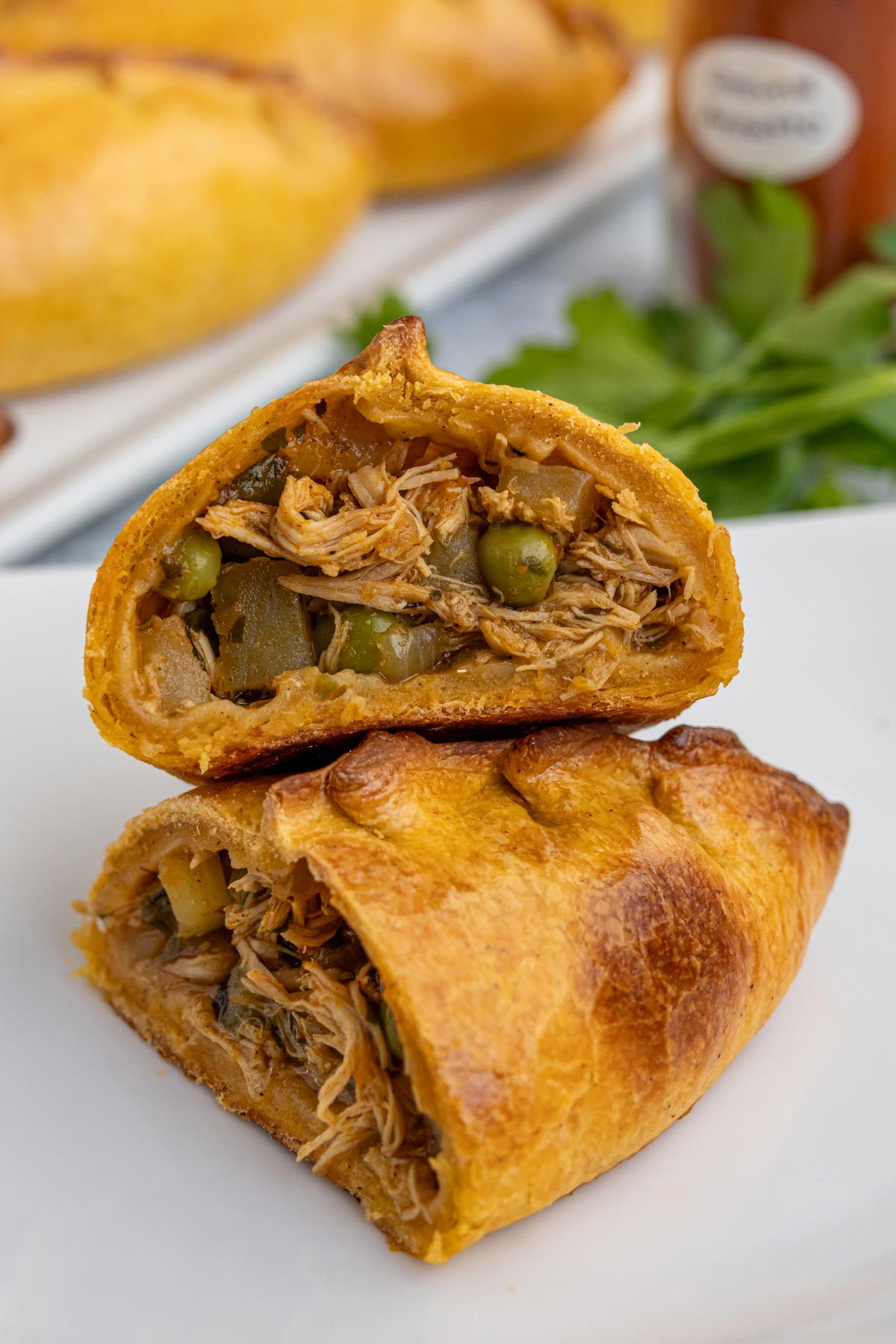
How to make the filling
In a large, heat-resistant glass or ceramic bowl, combine broth and gelatin. Let it sit for 2 minutes to bloom, then heat the gelatin mixture in the microwave on high for 1 ½ minutes, until the gelatin dissolves. Set aside.
Heat oil in a large skillet over medium-high heat. Add chopped onions and peppers and cook until softened. Add paprika and annatto.
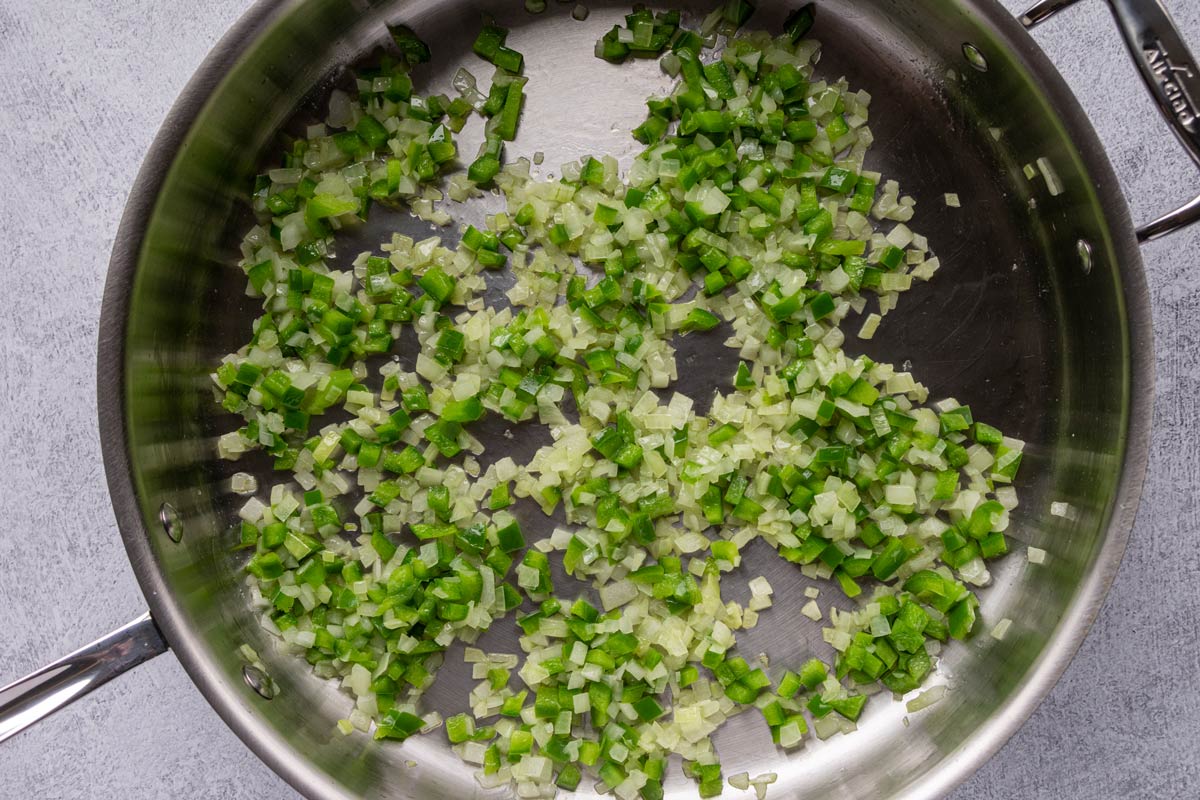
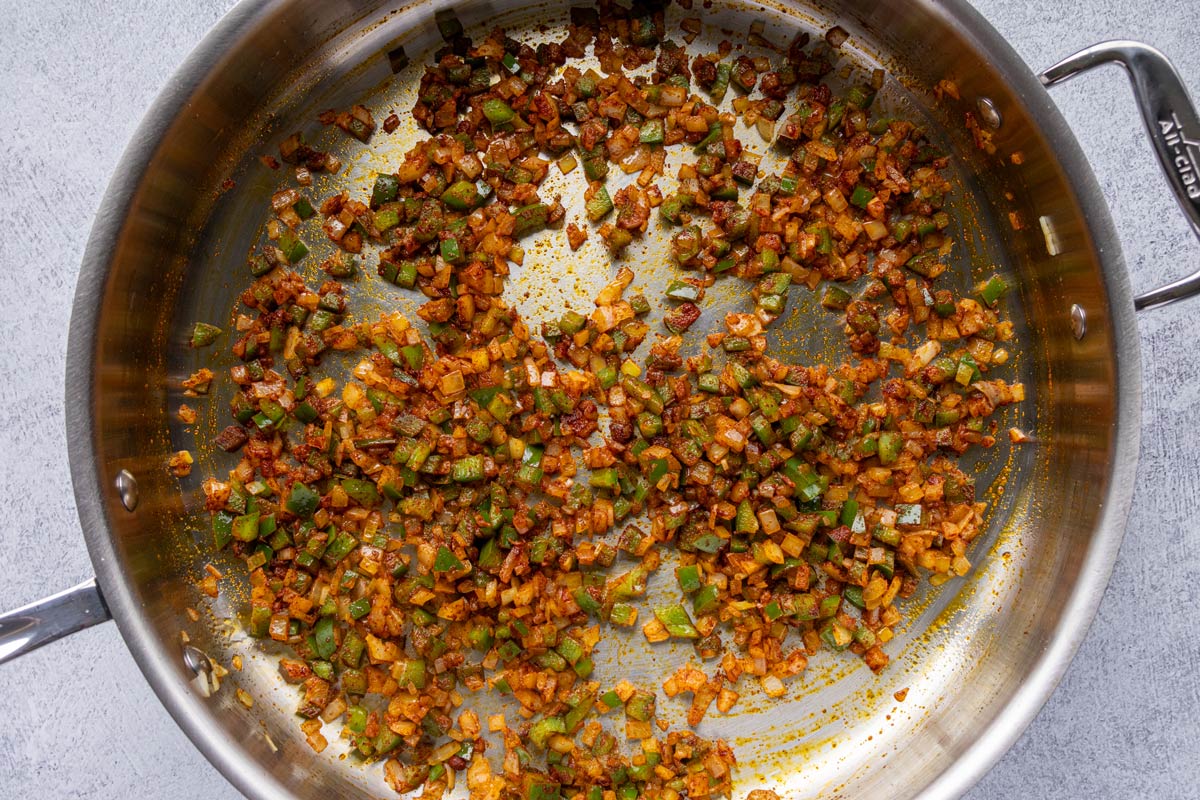
Next, add the broth mixture, stirring until the spices dissolve.
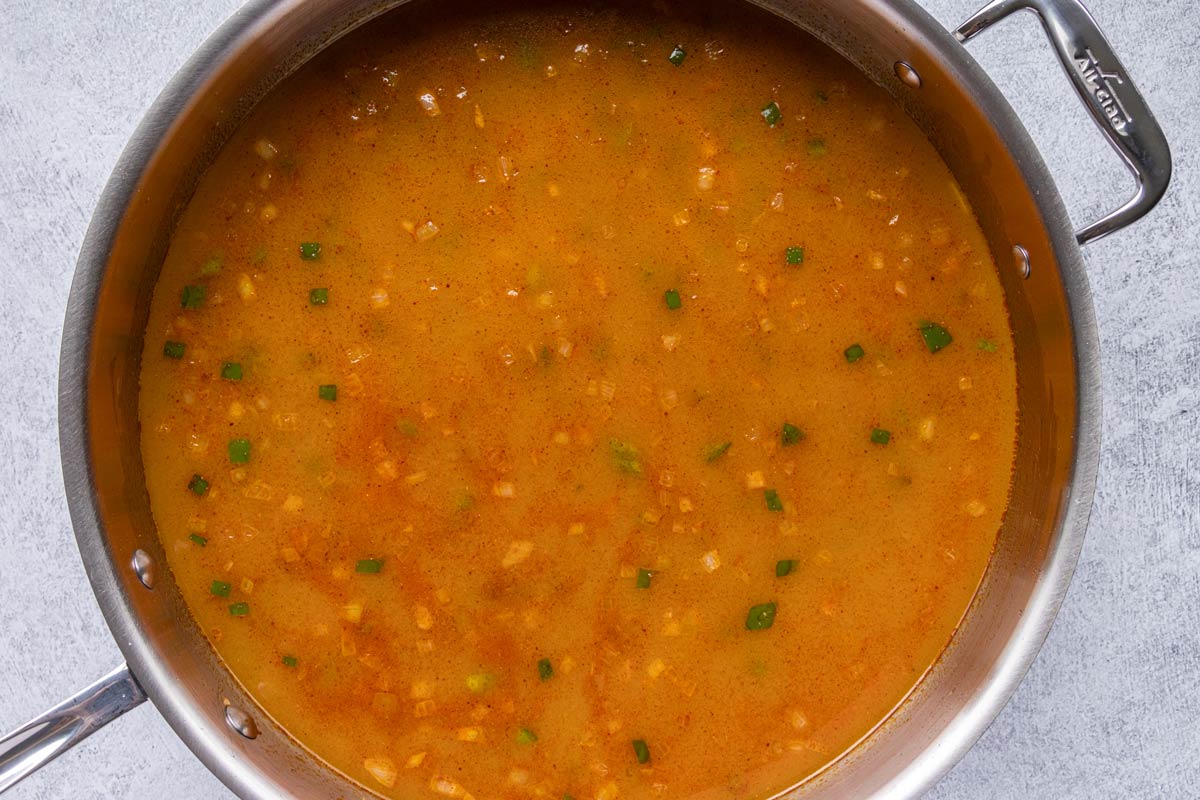
Finally, add diced potatoes, shredded chicken, peas, parsley, sugar, oregano, salt, cumin, and black pepper.
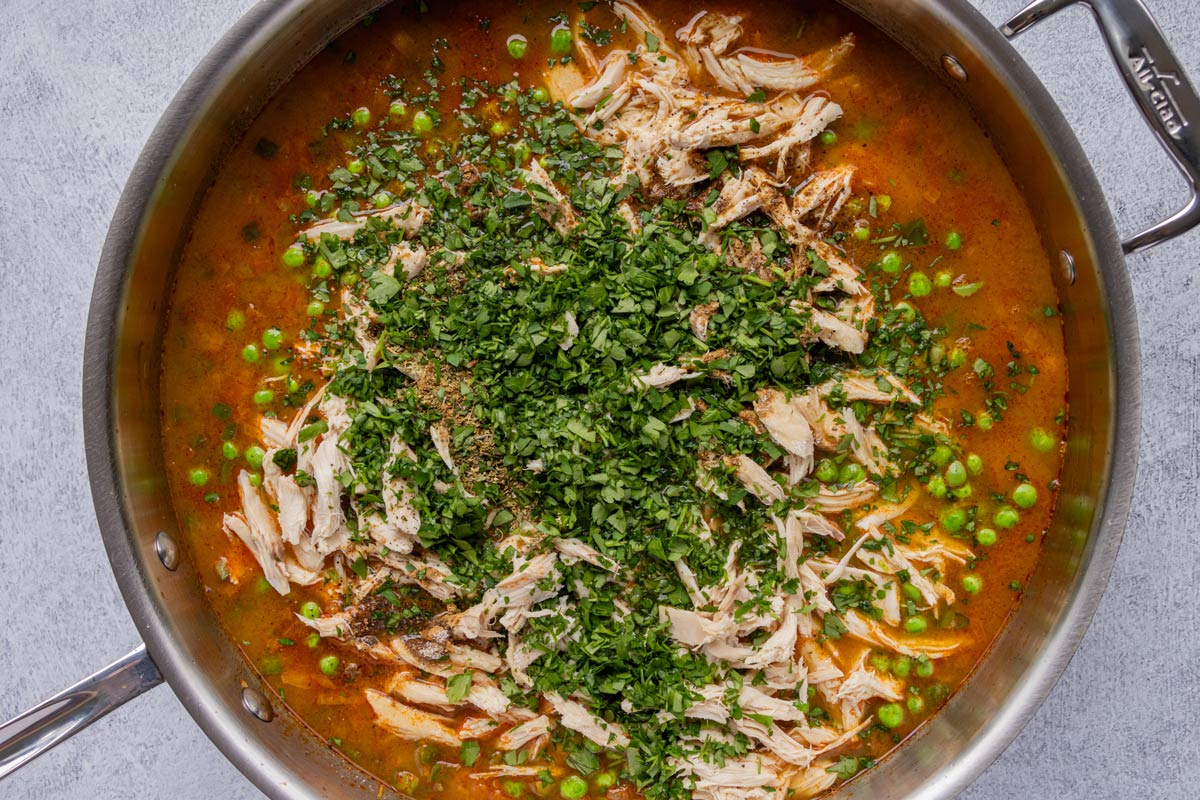
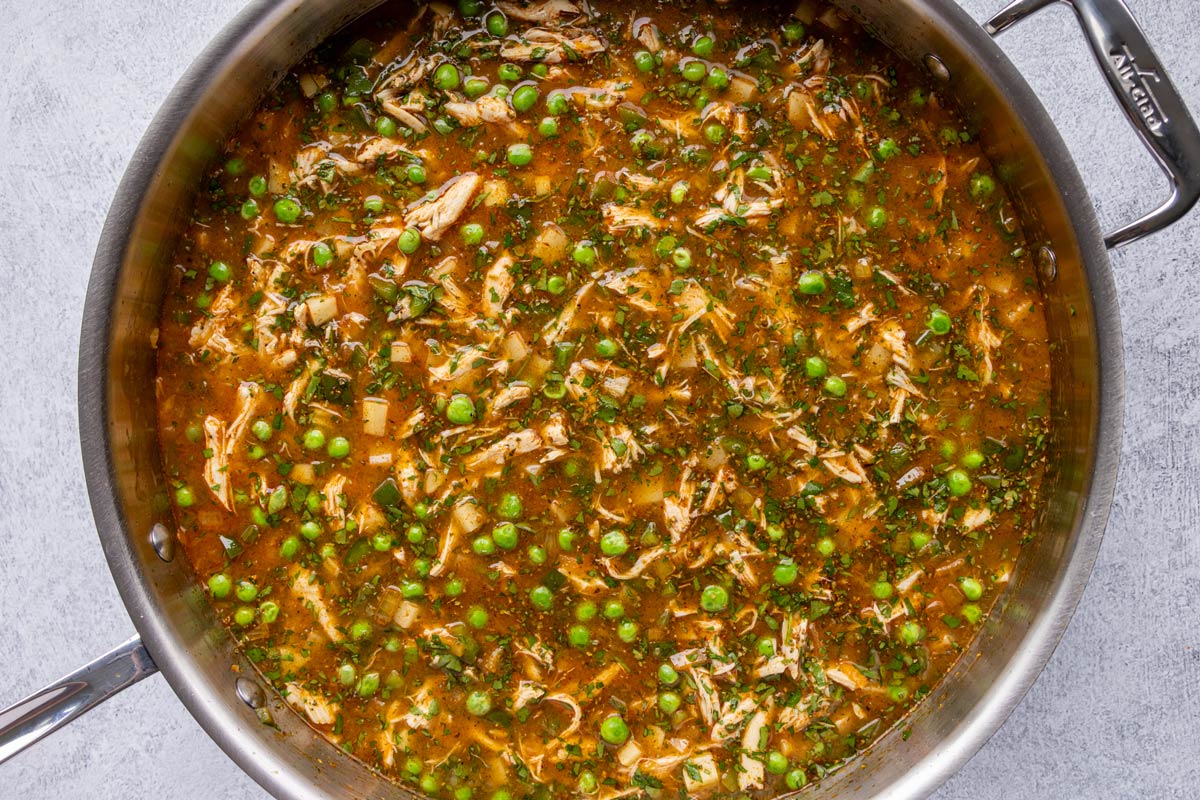
Bring to a boil and cook, uncovered, until the potatoes are tender. Adjust seasoning as necessary.
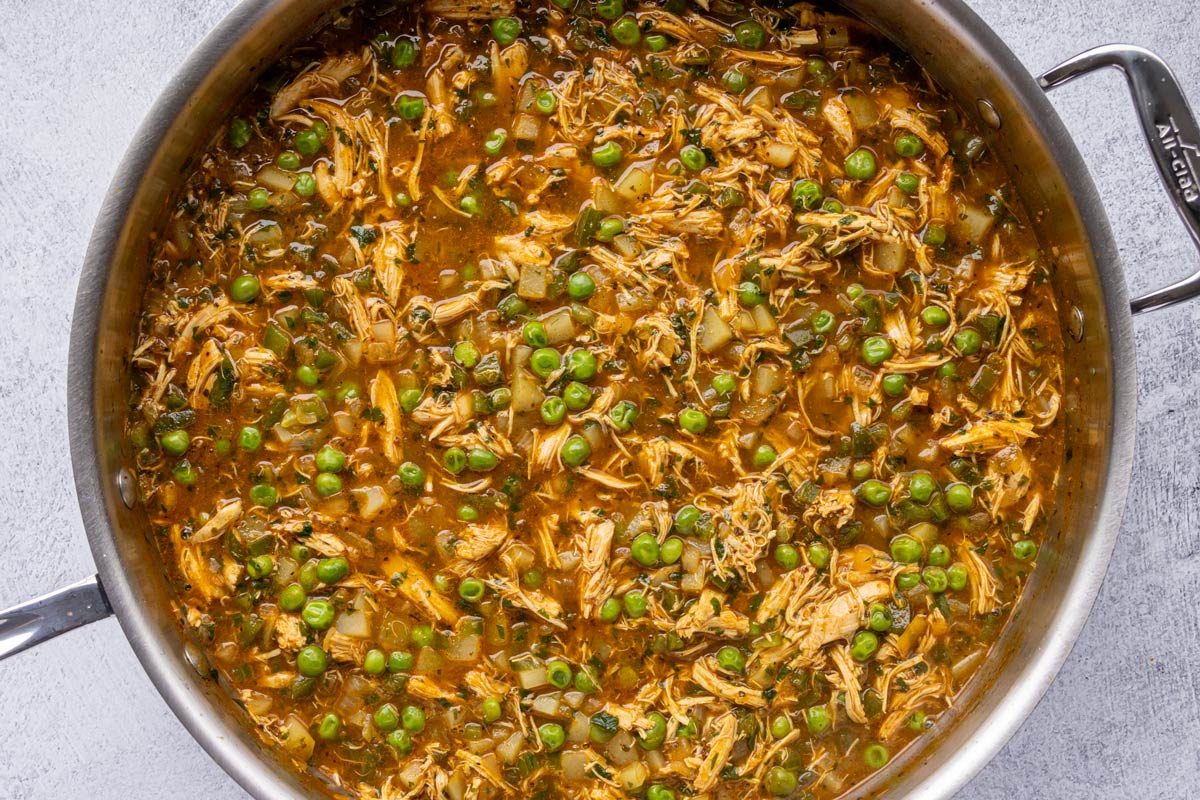
Transfer the stew to a bowl or container with a lid and cool completely. You’ll have about 6 cups of filling. Cover and chill for at least 4 hours or overnight (the mixture will jell).
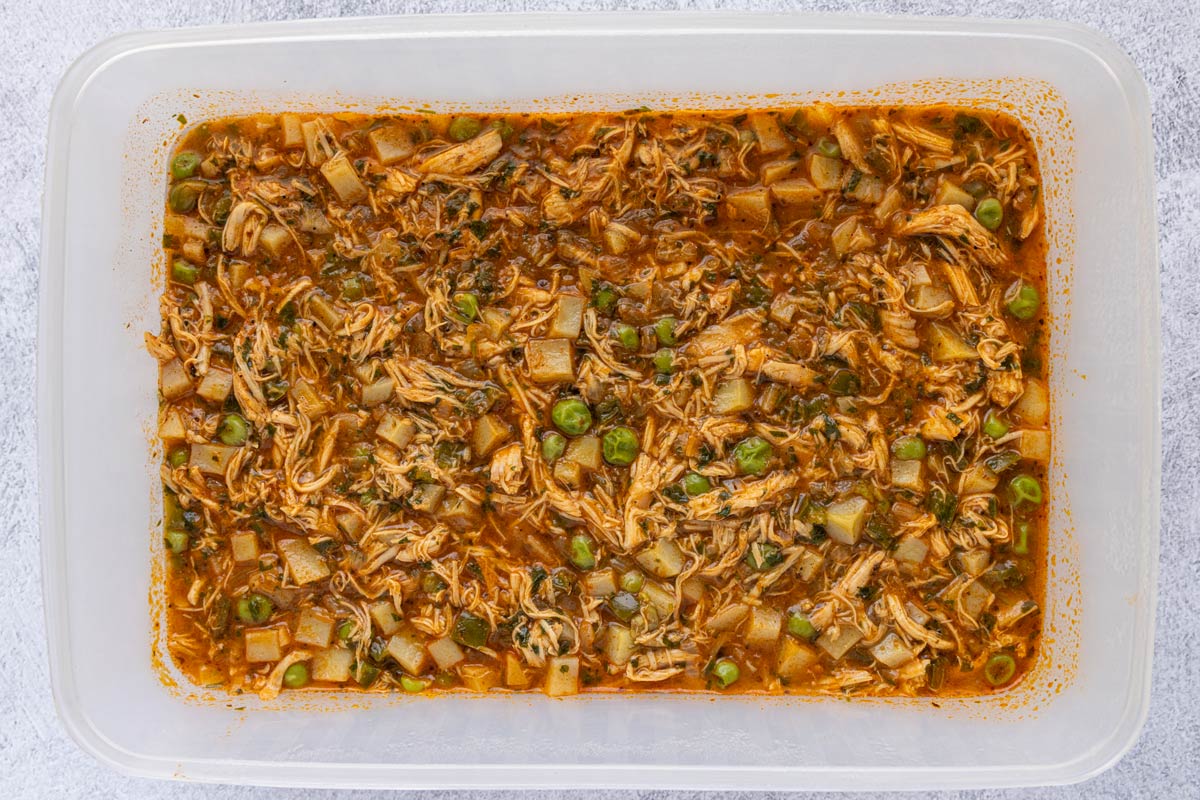
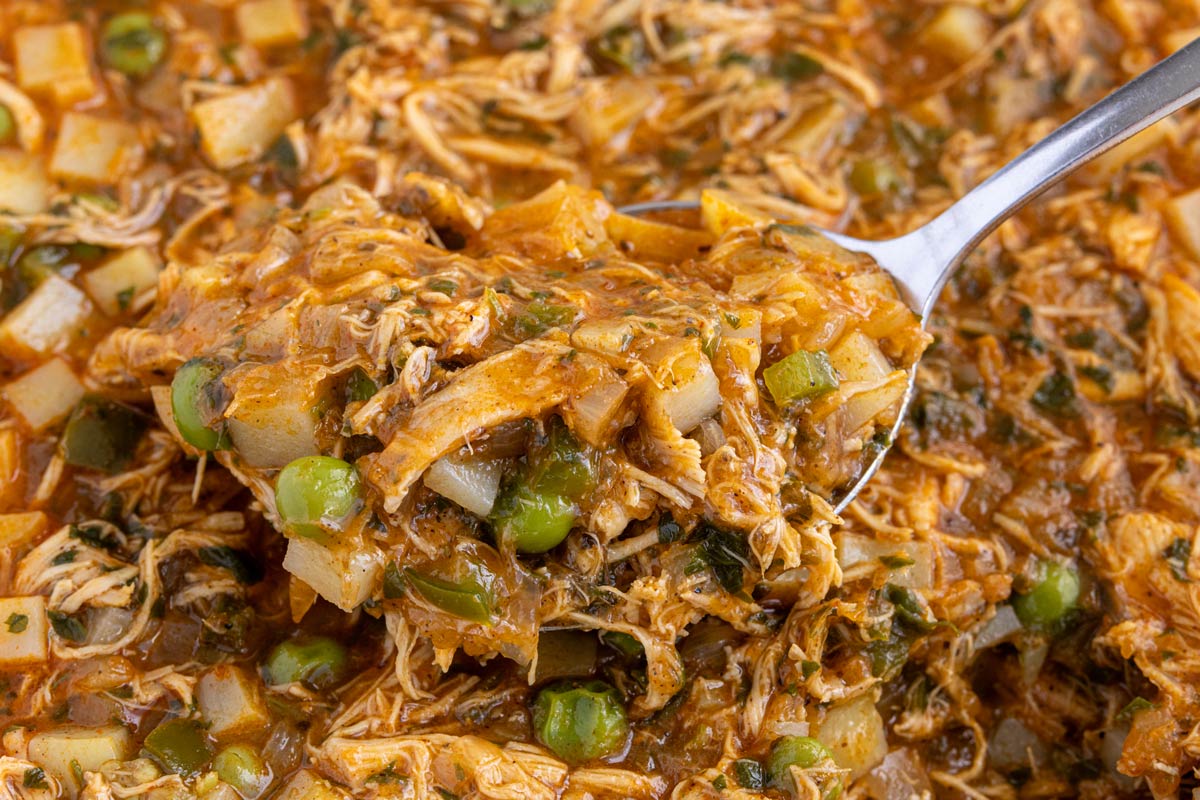
How to make the dough
In a medium saucepan over medium heat, combine butter and annatto and melt to infuse the butter with color. Remove and set aside to slightly cool.
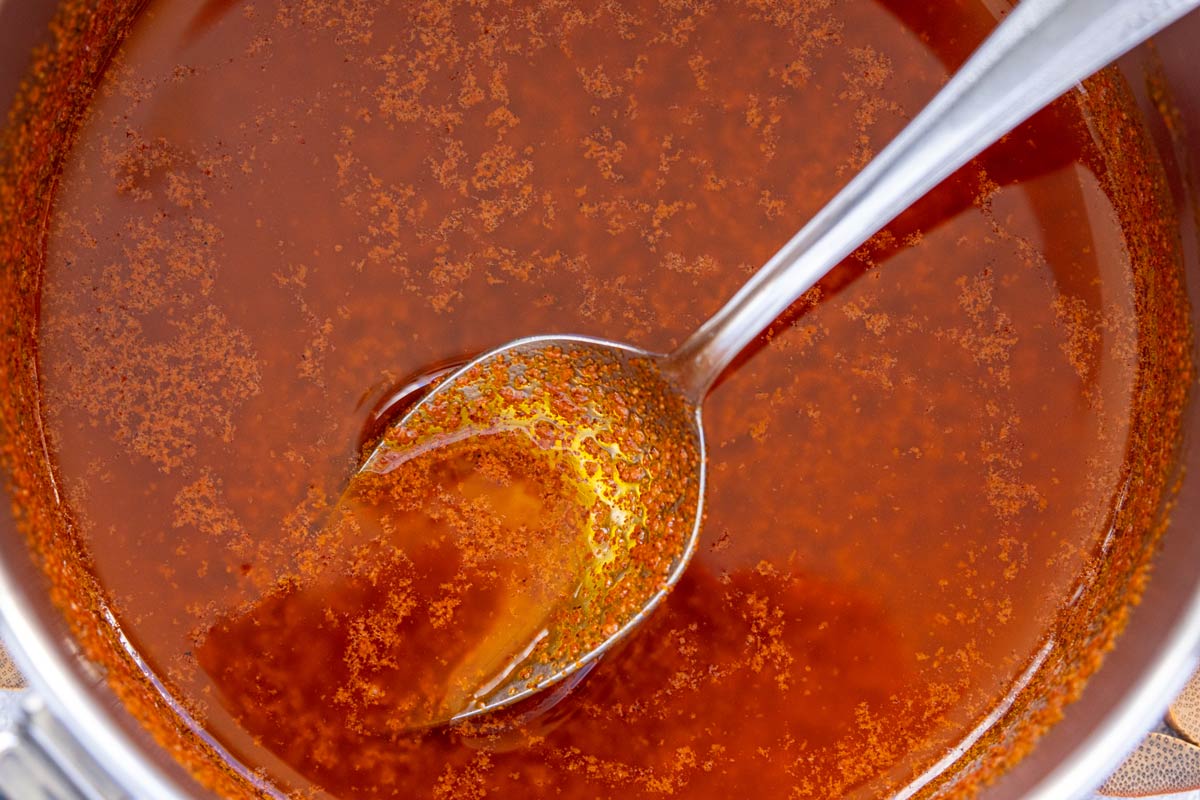
In a large bowl, whisk together flour, sugar, and salt. Make a well in the center and add an egg yolk and the slightly cooled butter.
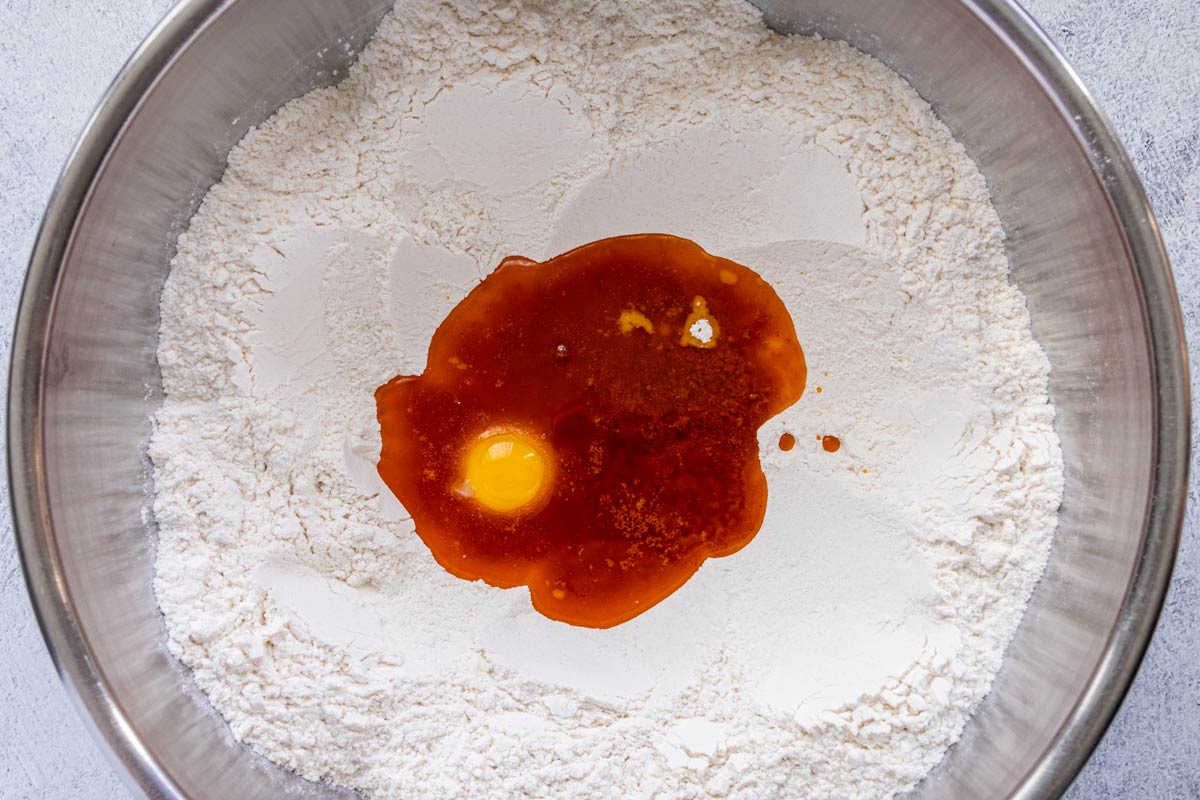
Using a wooden spatula, begin to mix everything together while slowly adding hot water. The dough should come together into a smooth ball after kneading it together for a couple minutes, and should spring back when gently pressed with a fingertip.
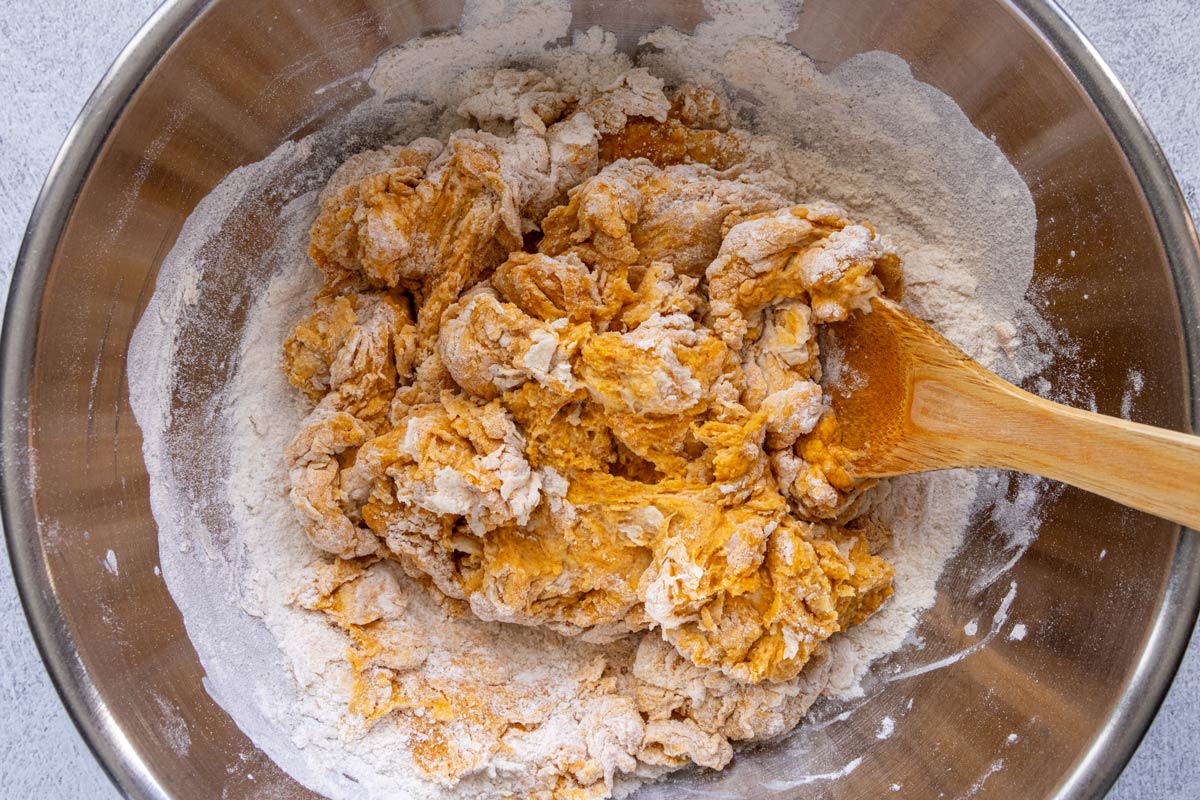
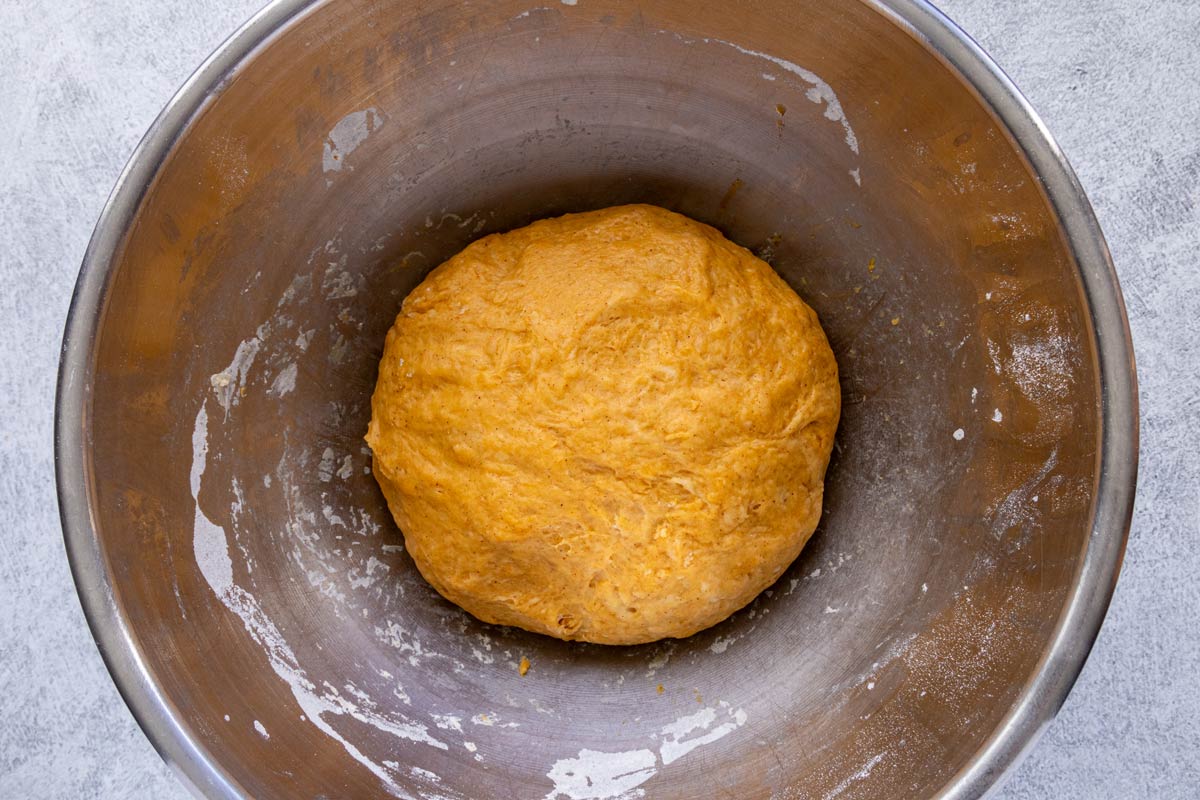
How to assemble and bake the salteñas
Line 2 to 3 baking sheets with parchment paper and set aside. Divide the dough into 20 equal portions (about 70 grams each). Fold each piece of dough onto itself to create smooth balls.
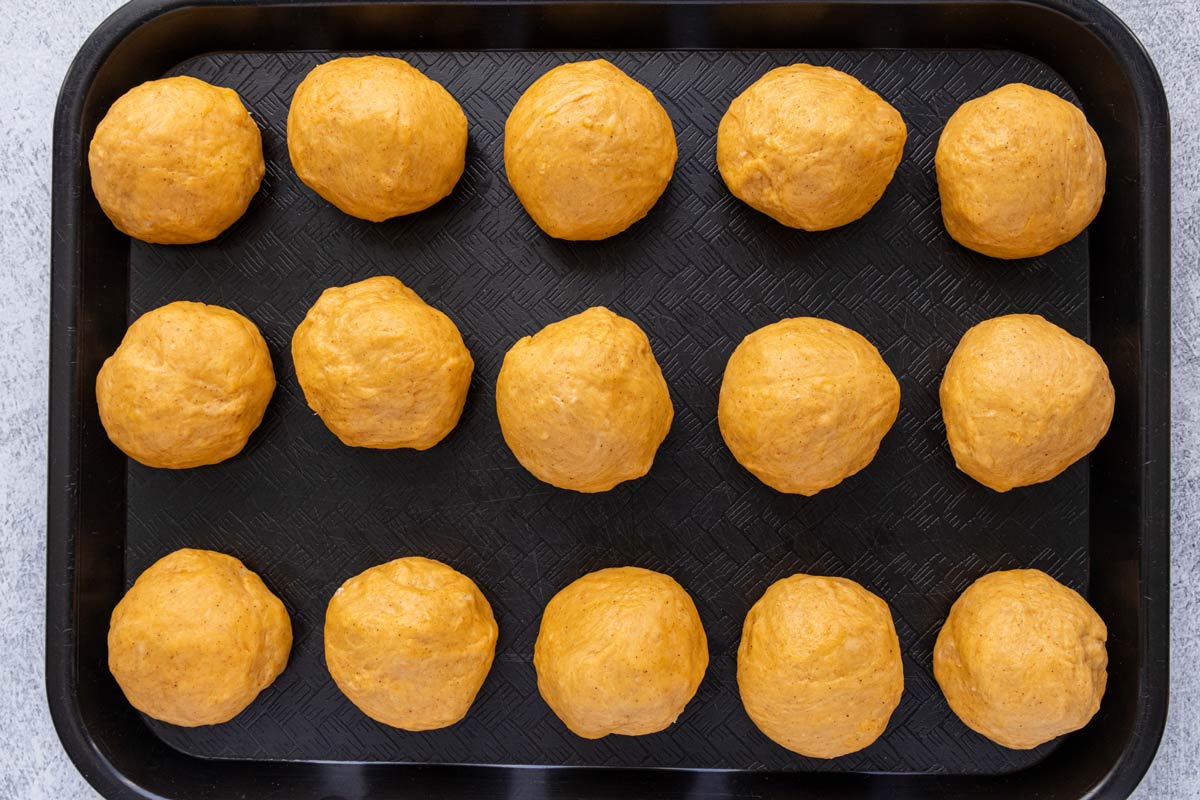
Work with one piece of dough at a time and cover the remaining balls of dough. Flatten the ball slightly into a disc. Line a tortilla press with a zip-top freezer or sandwich bag that has been cut open on two sides so that it opens like a book. Place the disc in the middle of the tortilla press between the plastic and press the dough into a 6-inch disc about ⅛-inch thick (or roll it out with a rolling pin).
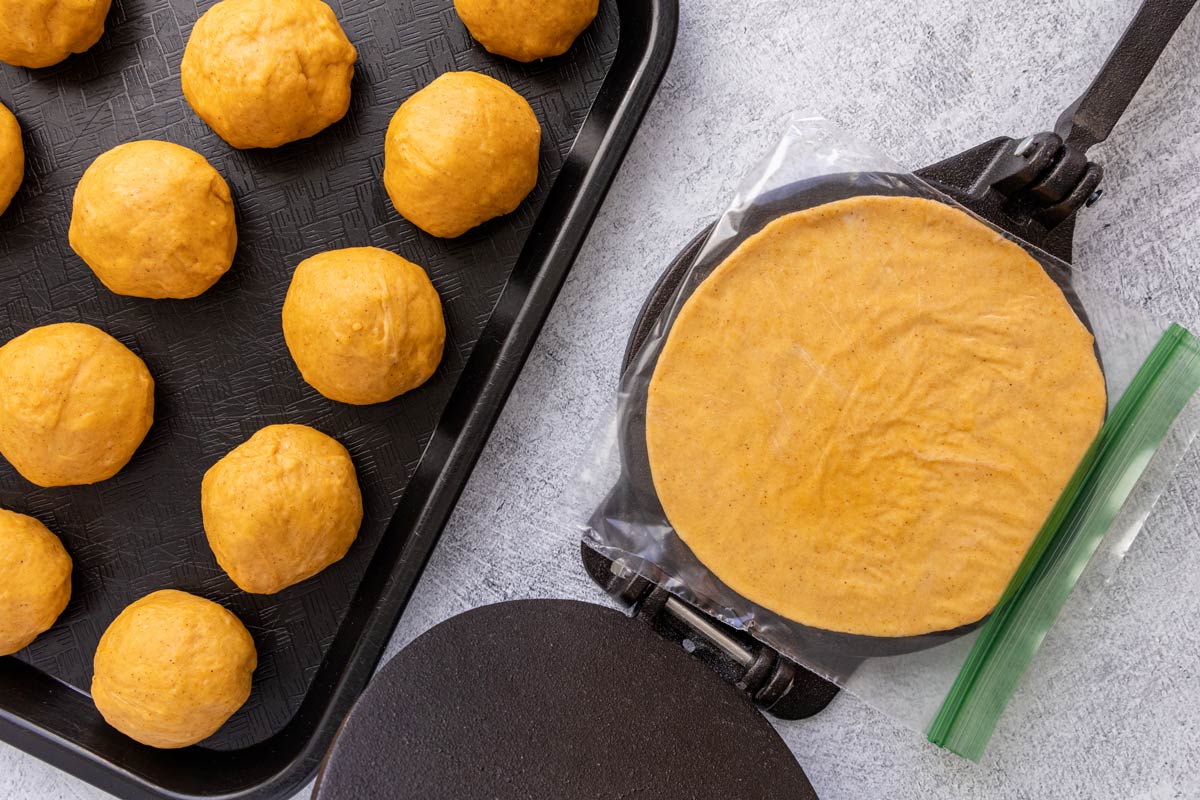
Place about ⅓ cup of jelled filling in the middle of the disc. If desired, add a slice of hard-boiled egg, an olive, and/or a spoonful of raisins.
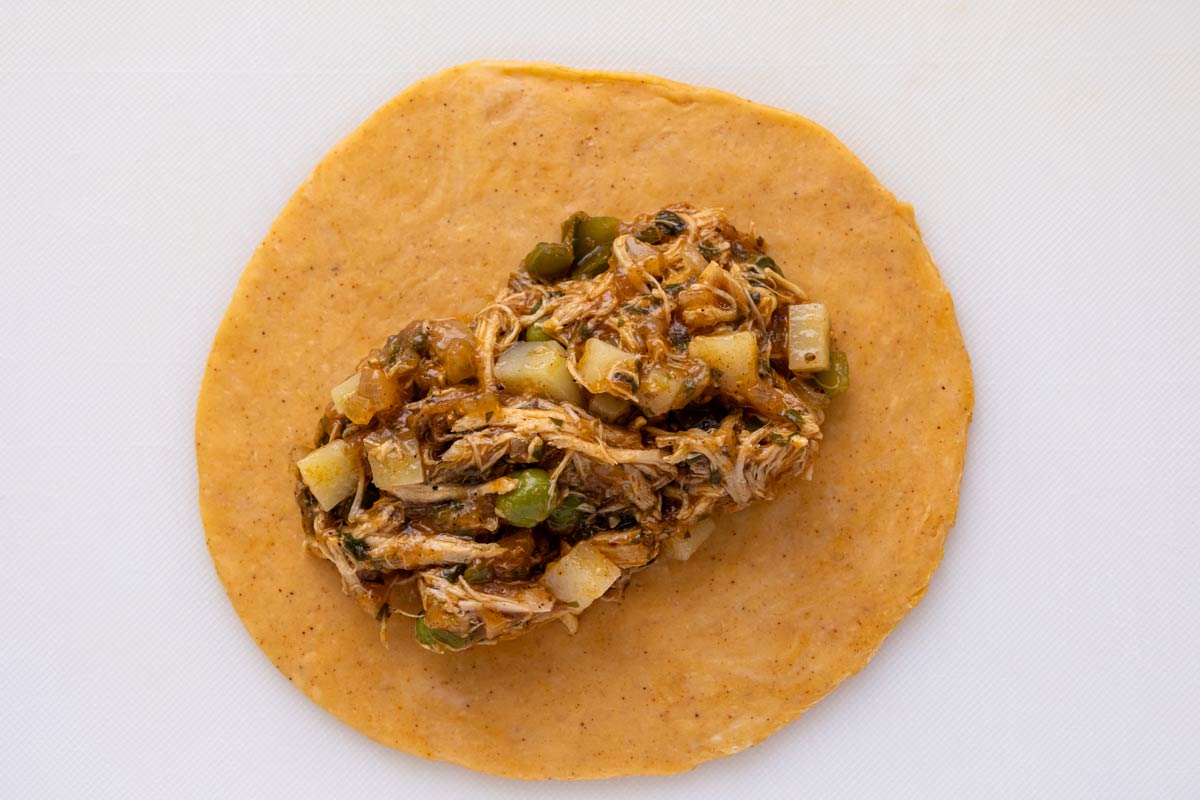
Bring the edges of the pastry together, letting the dough gently stretch over the filling. Enclose the filling (press the filling down with your forefinger to compact it). Form a half-moon and, holding it by the top edges, stand it on its bottom, flattening it so it can stand without toppling.
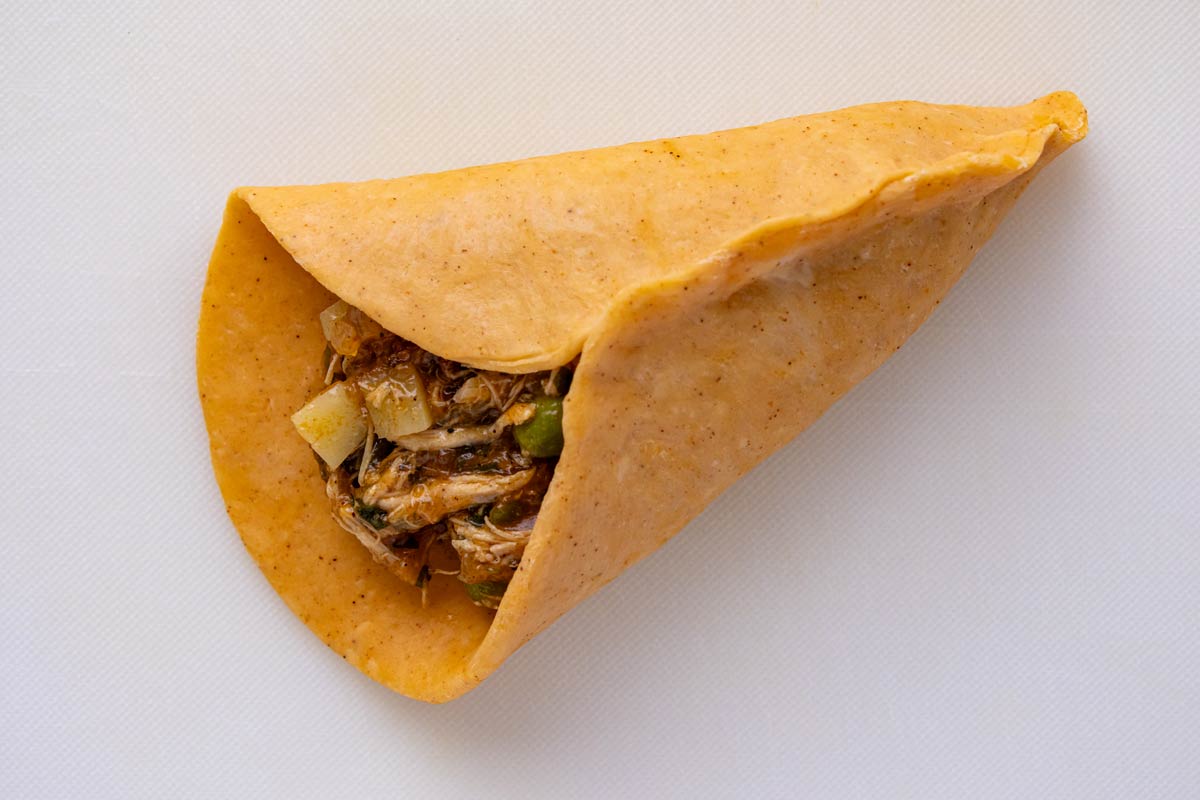
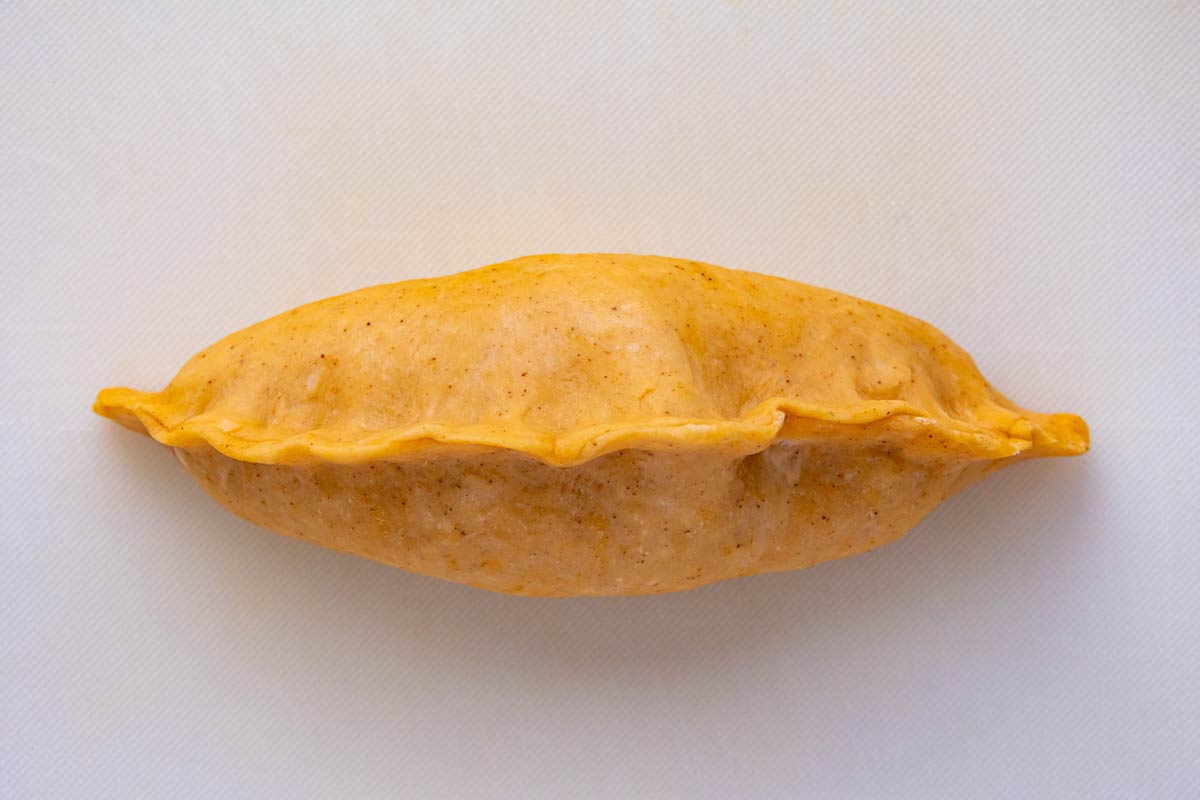
Pinch the edges tightly, and press to form a small rim, about ½ inch wide. Then pinch and fold sections of the rim decoratively to seal it well. Repeat with the remaining dough and filling.

Arrange the salteñas on the prepared pans, cover and chill them in the refrigerator for at least 20 minutes (or up to 2 hours). Do not crowd the salteñas together on the baking sheets, or their sides will stick when they bake.
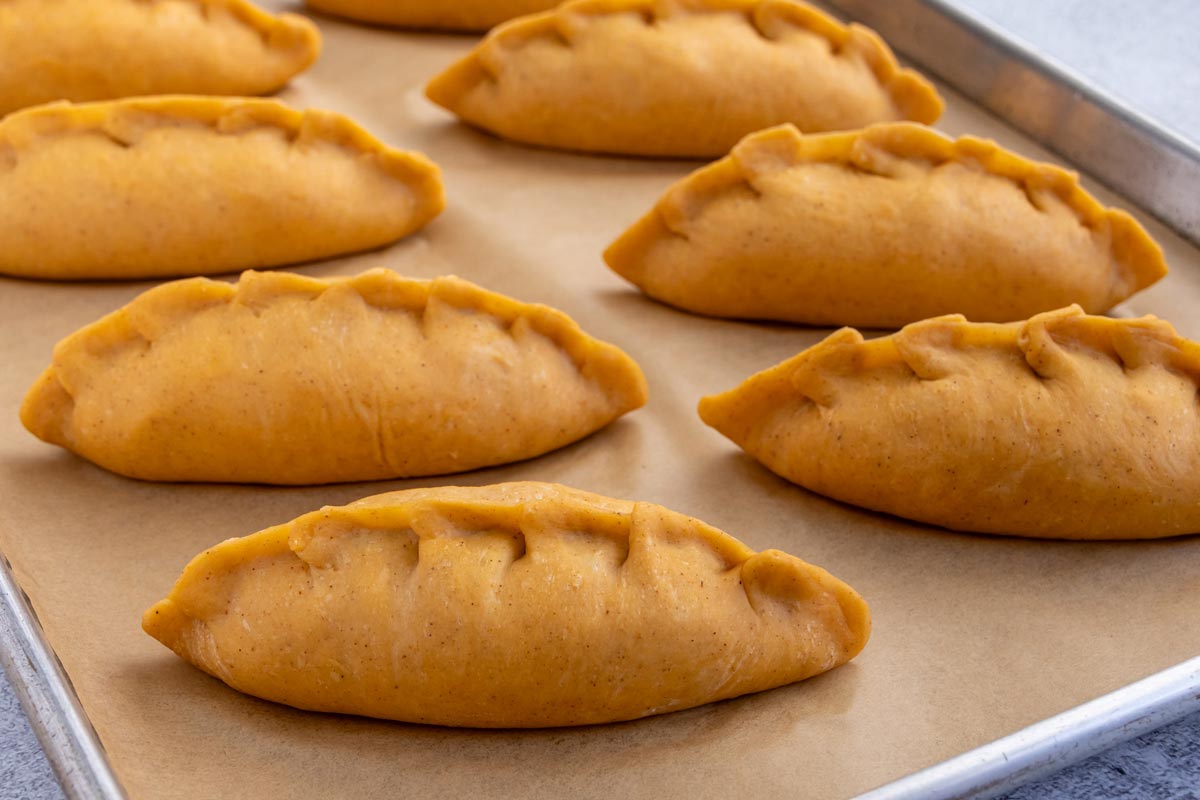
Preheat the oven to 500°F (260°C) with the rack in the center. Brush the salteñas evenly with egg wash.
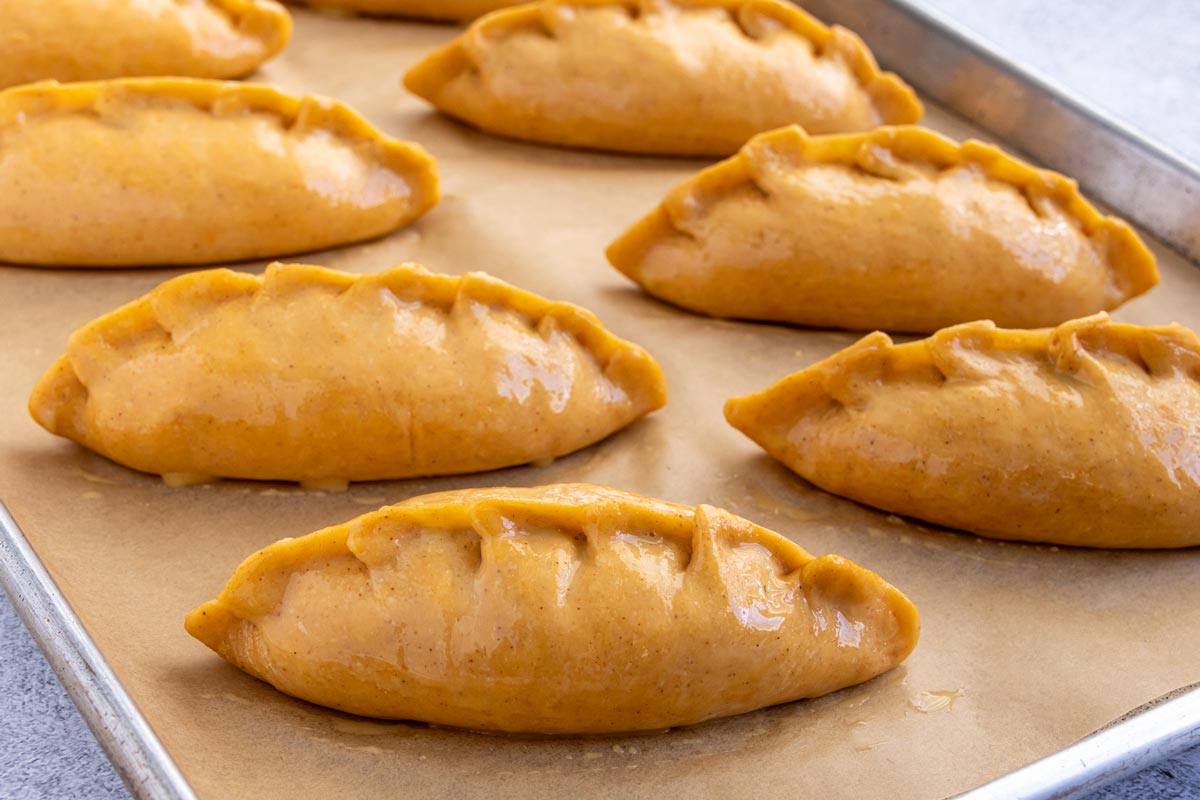
Bake each pan individually (keeping the others in the refrigerator until needed) for 20 to 22 minutes, or until they are golden. Cool salteñas for 5 to 10 minutes before serving.
Please scroll to the bottom of the post for the full recipe (in a printable recipe card) including ingredient amounts and detailed instructions.
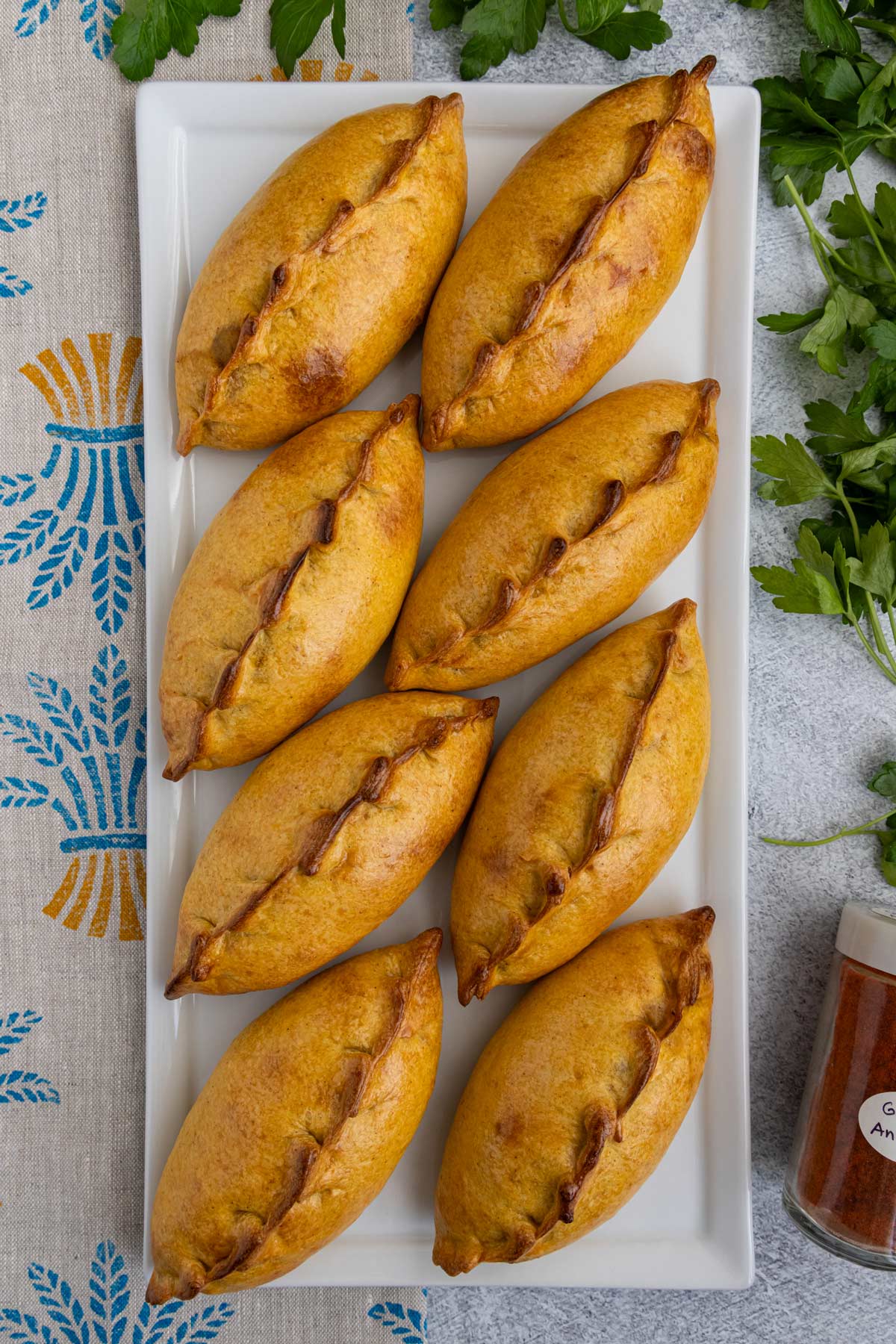
Expert tips
I recommend baking the salteñas in batches, one pan at a time on the center rack, so they will bake more evenly rather than rotating the pans. Keep the unbaked salteñas in the fridge until you’re ready to brush with egg wash and bake them.
Although salteñas often include hard boiled egg, olives, and/or raisins, I leave them out because I like them plain. If you decide to add these ingredients to yours, you certainly can. Just keep in mind that the filling is usually plenty to fill the dough wrappers, and you might need to add a bit less filling to make room for other ingredients before sealing them closed.
Even if a few of your salteñas leak while baking, don’t panic! They will still be delicious and juicy inside. This can easily happen at weak spots in the dough, particularly along the seam. Even if you press it closed really well and pleat it, inevitably a few salteñas may still leak.
Store leftover salteñas in a covered container in the fridge for 4 to 5 days. Reheat them in a 350°F oven or toaster oven until heated through, about 10 minutes.
Freeze the baked salteñas in a single layer. When solid, transfer to containers and freeze for up to 4 months. Reheat them in a 350°F oven or toaster oven until heated through, about 15 to 20 minutes.
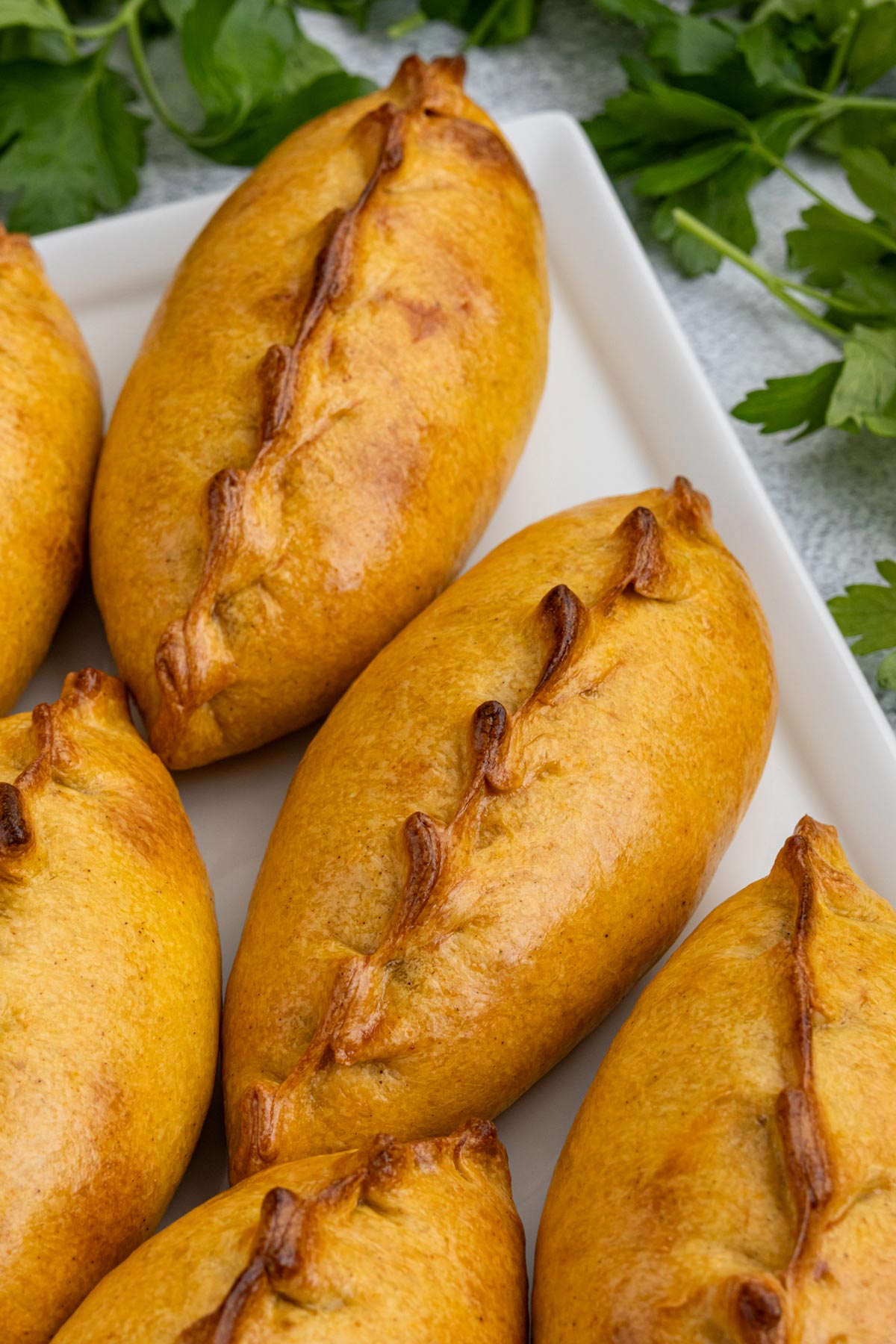
Other recipes you may like
- Jamaican Beef Patties
- Argentinian Beef Empanadas Tucumanas (Hand-Cut Beef, Egg, and Green Onion Empanadas)
- Ham and Cheese Empanadas
- Sweet Potato Black Bean Empanadas
- Venezuelan Black Bean and Cheese “Domino” Empanadas
Tried this recipe? Please leave a star ⭐️⭐️⭐️⭐️⭐️ rating in the recipe card below and/or a review in the comments section further down the page. You can also follow me on social media on Facebook, Instagram, and Pinterest!

Bolivian Salteñas de Pollo (Golden Chicken, Potato, and Pea Empanadas)
Ingredients
Filling:
- 4 cups chicken broth
- 1 tablespoon (1 packet) unflavored gelatin powder
- 2 tablespoons vegetable oil
- 1 cup (130 grams) finely chopped white onions
- 1 cup (130 grams) finely chopped green bell peppers
- 1 tablespoon paprika
- 1 ½ teaspoons ground annatto
- 2 cups (300 grams) peeled and finely chopped Yukon gold or yellow potatoes
- 2 cups (280 grams) packed shredded poached or roasted chicken
- 1 cup (120 grams) green peas
- ½ cup (20 grams) finely chopped fresh parsley
- 1 tablespoon sugar
- 1 tablespoon dried oregano
- 2 to 3 teaspoons Diamond Crystal brand kosher salt (start with about half that much if using another brand and add more as needed; amount needed will also depend on saltiness of broth)
- 1 ½ teaspoons ground cumin
- ¼ teaspoon freshly ground black pepper
Dough:
- ⅔ cup (150 grams) unsalted butter
- 2 ½ teaspoons ground annatto
- 6 ⅓ cups (800 grams) all-purpose flour
- ⅓ cup (65 grams) sugar
- 2 ½ teaspoons Diamond Crystal brand kosher salt or 1 ½ teaspoons fine salt
- 1 large egg yolk
- 1 ⅔ cups hot water (115°F)
Assembly:
- Pitted black olives (optional)
- Sliced hard-boiled eggs (optional)
- Raisins (optional)
- 1 large egg beaten with 2 teaspoons water
Instructions
Filling:
- In a large, heat-resistant glass or ceramic bowl, combine the broth and gelatin. Let it sit for 2 minutes to bloom, then heat the gelatin mixture in the microwave on high for 1 ½ minutes, until the gelatin dissolves (or over medium-low heat in a double boiler for 3 to 4 minutes). Set aside.
- Heat the oil in a large skillet over medium-high heat. Add the onions and peppers and cook until softened, about 3 to 4 minutes. Add paprika and annatto and cook for another 30 seconds. Next, add the broth mixture, stirring until the spices dissolve.
- Finally, add the potatoes, chicken, peas, parsley, sugar, oregano, salt, cumin, and black pepper. Bring to a boil and cook, uncovered, until the potatoes are tender, about 6 to 7 minutes. Adjust seasoning as necessary.
- Transfer the stew to a bowl or container with a lid and cool completely. You’ll have about 6 cups of filling. Cover and chill for at least 4 hours or overnight (the mixture will jell).
Dough:
- In a medium saucepan over medium heat, combine the butter and annatto and melt to infuse the butter with color. Remove and set aside to slightly cool.
- In a large bowl, whisk together the flour, sugar, and salt. Make a well in the center and add the egg yolk and slightly cooled butter. Using a wooden spatula, begin to mix everything together while slowly adding the hot water. The dough should come together into a smooth ball after kneading it together for a couple minutes. Add more flour if the mixture feels too wet or sticky. The dough should spring back when gently pressed with a fingertip.
Assembly and Baking:
- Line 2 to 3 baking sheets with parchment paper and set aside. Divide the dough into 20 equal portions (about 70 grams each). Fold each piece of dough onto itself to create smooth balls.
- Work with one piece of dough at a time and cover the remaining balls of dough. Flatten the ball slightly into a disc. Line a tortilla press with a zip-top freezer or sandwich bag that has been cut open on two sides so that it opens like a book. Place the disc in the middle of the tortilla press between the plastic and press the dough into a 6-inch disc about ⅛-inch thick (or roll it out with a rolling pin).
- Place about ⅓ cup of jelled filling in the middle of the disc. If desired, add a slice of hard-boiled egg, an olive, and/or a spoonful of raisins. Bring the edges of the pastry together, letting the dough gently stretch over the filling. Enclose the filling (press the filling down with your forefinger to compact it). Form a half-moon and, holding it by the top edges, stand it on its bottom, flattening it so it can stand without toppling.
- Pinch the edges tightly, and press to form a small rim, about ½ inch wide. Then pinch and fold sections of the rim decoratively to seal it well (as you would a dumpling, by gathering the dough starting at one end and pressing it together at ½-inch intervals, until it’s all sealed, OR folding the edge over onto itself to create a rope-like seam like you would for an empanada or curry puff). Repeat with the remaining dough and filling.
- Stand the salteñas on the prepared pans, cover and chill them in the refrigerator for at least 20 minutes (or up to 2 hours). Do not crowd the salteñas together on the baking sheets, or their sides will stick when they bake.
- Preheat the oven to 500°F (260°C) with the rack in the center. Brush the salteñas evenly with the egg wash and bake each pan individually (keeping the others in the refrigerator until needed) for 20 to 22 minutes, or until they are golden. Cool the salteñas for 5 to 10 minutes before serving.
Notes
- Store leftover salteñas in a covered container in the fridge for 4 to 5 days. Reheat them in a 350°F oven or toaster oven until heated through, about 10 minutes.
- Freeze the baked salteñas in a single layer. When solid, transfer to containers and freeze for up to 4 months. Reheat them in a 350°F oven or toaster oven until heated through, about 15 to 20 minutes.
- I recommend baking the salteñas in batches, one pan at a time on the center rack, so they will bake more evenly rather than rotating the pans. Keep the unbaked salteñas in the fridge until you’re ready to brush with egg wash and bake them.
- Although salteñas often include hard boiled egg, olives, and/or raisins, I leave them out because I like them plain. If you decide to add these ingredients to yours, you certainly can. Just keep in mind that the filling is usually plenty to fill the dough wrappers, and you might need to add a bit less filling to make room for other ingredients before sealing them closed.
- The measurements provided for the salt are specifically for Diamond Crystal brand, which features larger crystals of salt than some other brands, like Morton. I always recommend using my measurements as a guide, but tasting and seasoning based on your preference (and salt type). Start with less and add more as needed. The saltiness of your broth will also impact how much salt you’ll need to add to get the seasoning just right.
- Heavily adapted from Empanadas: The Hand-Held Pies of Latin America
Nutrition
*All nutritional information is based on third-party calculations and should be considered estimates. Actual nutritional content will vary with brands used, measuring methods, portion sizes and more.*






Steph says
Thanks for the recipe! I am looking through instructions on how you cook the chicken? Did I miss that?
Victoria says
Hi Steph,
You can cook the chicken by either poaching it or roasting it or use a store-bought rotisserie chicken. The measurements are for already cooked and shredded chicken so however you choose to cook the chicken before you shred it is fine. This would be a good use of leftover chicken too if you had it! I include some notes about the chicken (and the other ingredients) in the body of the post under the heading "Ingredient Notes" so it might be helpful to review some of that information as well before getting started. Good luck!
Donny Hilgeman says
The recipe looks good - although growing up in Bolivia both in Cochabamba and Santa Cruz I never had green peppers in the broth. The only recommendation I would make, is that if you truly want it to be an authentic salteña, you will need to add more sugar to the broth. Salteñas are spicy and sweet. You don’t want it to taste like a dessert but it does have to have a noticeable sweetness to it. The spiciness comes from ají- and a crucial additional spice is the cumin. An authentic salteña will be sweet and spicy, brothy, and cumin-spiced. Without any one of those components you may have a delicious empanada but not a salteña.